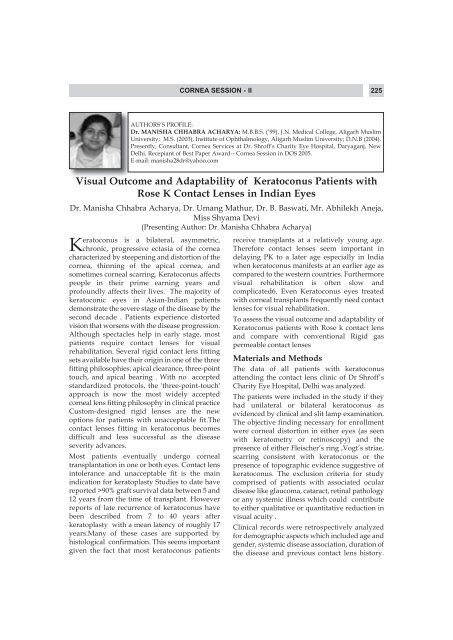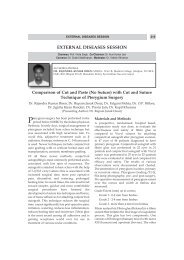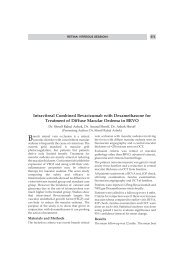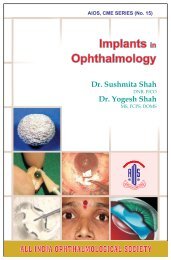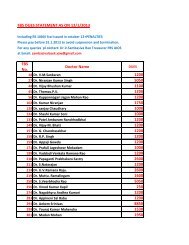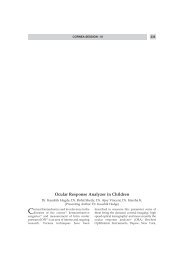Visual Outcome and Adaptability of Keratoconus Patients with Rose ...
Visual Outcome and Adaptability of Keratoconus Patients with Rose ...
Visual Outcome and Adaptability of Keratoconus Patients with Rose ...
Create successful ePaper yourself
Turn your PDF publications into a flip-book with our unique Google optimized e-Paper software.
CORNEA SESSION - II<br />
AUTHORS’S PROFILE:<br />
Dr. MANISHA CHHABRA ACHARYA: M.B.B.S. (’99), J.N. Medical College, Aligarh Muslim<br />
University; M.S. (2003), Institute <strong>of</strong> Ophthalmology, Aligarh Muslim University; D.N.B (2004).<br />
Presently, Consultant, Cornea Services at Dr. Shr<strong>of</strong>f’s Charity Eye Hospital, Daryaganj, New<br />
Delhi. Recepiant <strong>of</strong> Best Paper Award-- Cornea Session in DOS 2005.<br />
E-mail: manisha28dr@yahoo.com<br />
<strong>Visual</strong> <strong>Outcome</strong> <strong>and</strong> <strong>Adaptability</strong> <strong>of</strong> <strong>Keratoconus</strong> <strong>Patients</strong> <strong>with</strong><br />
<strong>Rose</strong> K Contact Lenses in Indian Eyes<br />
Dr. Manisha Chhabra Acharya, Dr. Umang Mathur, Dr. B. Baswati, Mr. Abhilekh Aneja,<br />
Miss Shyama Devi<br />
(Presenting Author: Dr. Manisha Chhabra Acharya)<br />
<strong>Keratoconus</strong> is a bilateral, asymmetric,<br />
chronic, progressive ectasia <strong>of</strong> the cornea<br />
characterized by steepening <strong>and</strong> distortion <strong>of</strong> the<br />
cornea, thinning <strong>of</strong> the apical cornea, <strong>and</strong><br />
sometimes corneal scarring. <strong>Keratoconus</strong> affects<br />
people in their prime earning years <strong>and</strong><br />
pr<strong>of</strong>oundly affects their lives. The majority <strong>of</strong><br />
keratoconic eyes in Asian-Indian patients<br />
demonstrate the severe stage <strong>of</strong> the disease by the<br />
second decade . <strong>Patients</strong> experience distorted<br />
vision that worsens <strong>with</strong> the disease progression.<br />
Although spectacles help in early stage, most<br />
patients require contact lenses for visual<br />
rehabilitation. Several rigid contact lens fitting<br />
sets available have their origin in one <strong>of</strong> the three<br />
fitting philosophies: apical clearance, three-point<br />
touch, <strong>and</strong> apical bearing . With no accepted<br />
st<strong>and</strong>ardized protocols, the 'three-point-touch'<br />
approach is now the most widely accepted<br />
corneal lens fitting philosophy in clinical practice<br />
Custom-designed rigid lenses are the new<br />
options for patients <strong>with</strong> unacceptable fit.The<br />
contact lenses fitting in keratoconus becomes<br />
difficult <strong>and</strong> less successful as the disease<br />
severity advances.<br />
Most patients eventually undergo corneal<br />
transplantation in one or both eyes. Contact lens<br />
intolerance <strong>and</strong> unacceptable fit is the main<br />
indication for keratoplasty Studies to date have<br />
reported >90% graft survival data between 5 <strong>and</strong><br />
12 years from the time <strong>of</strong> transplant. However<br />
reports <strong>of</strong> late recurrence <strong>of</strong> keratoconus have<br />
been described from 7 to 40 years after<br />
keratoplasty <strong>with</strong> a mean latency <strong>of</strong> roughly 17<br />
years.Many <strong>of</strong> these cases are supported by<br />
histological confirmation. This seems important<br />
given the fact that most keratoconus patients<br />
225<br />
receive transplants at a relatively young age.<br />
Therefore contact lenses seem important in<br />
delaying PK to a later age especially in India<br />
when keratoconus manifests at an earlier age as<br />
compared to the western countries. Furthermore<br />
visual rehabilitation is <strong>of</strong>ten slow <strong>and</strong><br />
complicated6. Even <strong>Keratoconus</strong> eyes treated<br />
<strong>with</strong> corneal transplants frequently need contact<br />
lenses for visual rehabilitation.<br />
To assess the visual outcome <strong>and</strong> adaptability <strong>of</strong><br />
<strong>Keratoconus</strong> patients <strong>with</strong> <strong>Rose</strong> k contact lens<br />
<strong>and</strong> compare <strong>with</strong> conventional Rigid gas<br />
permeable contact lenses<br />
Materials <strong>and</strong> Methods<br />
The data <strong>of</strong> all patients <strong>with</strong> keratoconus<br />
attending the contact lens clinic <strong>of</strong> Dr Shr<strong>of</strong>f’s<br />
Charity Eye Hospital, Delhi was analyzed.<br />
The patients were included in the study if they<br />
had unilateral or bilateral keratoconus as<br />
evidenced by clinical <strong>and</strong> slit lamp examination.<br />
The objective finding necessary for enrollment<br />
were corneal distortion in either eyes (as seen<br />
<strong>with</strong> keratometry or retinoscopy) <strong>and</strong> the<br />
presence <strong>of</strong> either Fleischer’s ring ,Vogt’s striae,<br />
scarring consistent <strong>with</strong> keratoconus or the<br />
presence <strong>of</strong> topographic evidence suggestive <strong>of</strong><br />
keratoconus. The exclusion criteria for study<br />
comprised <strong>of</strong> patients <strong>with</strong> associated ocular<br />
disease like glaucoma, cataract, retinal pathology<br />
or any systemic illness which could contribute<br />
to either qualitative or quantitative reduction in<br />
visual acuity .<br />
Clinical records were retrospectively analyzed<br />
for demographic aspects which included age <strong>and</strong><br />
gender, systemic disease association, duration <strong>of</strong><br />
the disease <strong>and</strong> previous contact lens history.
226 AIOC 2010 PROCEEDINGS<br />
Clinical parameters studied included unaided<br />
visual acuity, best corrected visual acuity <strong>with</strong><br />
spectacles <strong>and</strong> <strong>with</strong> contact lenses. The visual<br />
acuity was assessed using Snellen acuity chart for<br />
distance <strong>and</strong> near <strong>with</strong> glasses, RGP <strong>and</strong> ROSE-<br />
K lenses <strong>and</strong> was then converted to log MAR<br />
values. Detailed slit lamp examination was done.<br />
Lens centration <strong>and</strong> movement was noted <strong>and</strong><br />
the type <strong>of</strong> fit recorded. Values <strong>of</strong> keratometry,<br />
corneal topography <strong>and</strong> Schirmer’test were<br />
noted.<br />
The grading <strong>of</strong> keratoconus based on<br />
keratometry was done for every patient. Grading<br />
based on keratometry was as follows:<br />
• Mild <strong>Keratoconus</strong> 52 D in 1<br />
or both meridiansan, • Severe keratoconus >62<br />
D in 1 or both meridians.<br />
The contact lens choice included conventional<br />
RGP contact lens, <strong>Rose</strong> k contact lens. The fit<br />
assessment <strong>of</strong> conventional RGP lens trial <strong>and</strong><br />
<strong>Rose</strong> K lens trial was done by evaluating the<br />
dynamic fit <strong>and</strong> static fit by fluorescein staining.<br />
The three point touch approach was followed for<br />
RGP lenses <strong>and</strong> feather touch for ROSE-K lenses.<br />
Any ocular discomfort or foreign body sensation<br />
<strong>with</strong> the lenses were noted. <strong>Patients</strong> who<br />
complained <strong>of</strong> discomfort <strong>with</strong> RGP lenses were<br />
advised <strong>Rose</strong>K lenses <strong>and</strong> followed up for any<br />
ocular irritability.<br />
Results<br />
68 eyes <strong>of</strong> 41<br />
patients were<br />
analyzed <strong>of</strong> which<br />
24 (58.5%) were<br />
males <strong>and</strong><br />
17(41.5%) were<br />
females; their<br />
median age was 26<br />
years.6eyes(9%)<br />
were diagnosed to have mild <strong>Keratoconus</strong>(52D) <strong>and</strong> 4 eyes (6%) had<br />
severe keratoconus(>62 D).<br />
Grade <strong>of</strong> keratoconus # <strong>of</strong> eyes Percentage<br />
Mild 6 6%<br />
Moderate 20 30%<br />
Advanced 37 55%<br />
Severe 4 9%<br />
Comparison <strong>of</strong> mean VA (RGP lenses <strong>with</strong><br />
ROSE-K)<br />
Difference -0.17913433<br />
St<strong>and</strong>ard error 0.028604459<br />
95% CI -0.235716777 to -0.122551883<br />
Test statistic t -6.262<br />
DF 132<br />
Significance level P < 0.0001<br />
Comparison <strong>of</strong> mean VA (Glasses <strong>with</strong><br />
ROSE K)<br />
Difference 0.59958209<br />
St<strong>and</strong>ard error 0.046868987<br />
95% CI 0.506870602 to 0.692293578<br />
Test statistic t 12.793<br />
DF 132<br />
Significance level P < 0.0001<br />
Main reason for drop out <strong>with</strong> conventional RGP<br />
lenses was popping lens(3 eyes), edge lift(10<br />
eyes), decreased BCVA(1 eyes) <strong>and</strong> in 35 eyes<br />
patients were more comfortable <strong>with</strong> <strong>Rose</strong> K<br />
contact lens. With <strong>Rose</strong> K contact lens BCVA<br />
improved to 6/9 (0.18 logMAR) or better in 91.2%<br />
(62 eyes) <strong>and</strong> all improved to 6/18 (0.48<br />
logMAR)/better as compared to RGP contact<br />
lenses where 60.2% (41 eyes) improved to<br />
6/9(0.18 logMAR)/better<br />
Out <strong>of</strong> the 35 eyes 17 had a superior adaptability<br />
<strong>with</strong> <strong>Rose</strong>K lens, 6 patients had complains <strong>of</strong><br />
popping out after 2-3 hours <strong>of</strong> wear <strong>and</strong> 10<br />
patients had edge lift. 2 patients having an<br />
acceptable fit <strong>with</strong> both still preferred <strong>Rose</strong>K<br />
lenses over RGP lenses.<br />
Contact lens intolerance <strong>and</strong> unacceptable fit<br />
remains the main indication for keratoplasty in<br />
keratoconus patients. RGP contact lenses do not
CORNEA SESSION - II<br />
have acceptable fit <strong>with</strong> good adaptability in all<br />
keratoconus cases. <strong>Rose</strong> k lenses because <strong>of</strong> their<br />
unique design fit extremely well in patients <strong>with</strong><br />
severe keratoconus <strong>and</strong> must be considered as an<br />
option in patients who do not fit <strong>with</strong><br />
conventional RGP lenses before considering<br />
penetrating keratoplasty.<br />
Discussion<br />
<strong>Keratoconus</strong> is a condition in which the cornea<br />
assumes a complex irregular curvature caused by<br />
central corneal thinning. The abnormal<br />
topography <strong>of</strong> the cornea in combination <strong>with</strong><br />
central corneal scarring results in an impaired<br />
visual acuity. Even in mild cases spectacles do<br />
not correct vision adequately. Hence contact<br />
lenses remain the mainstay <strong>of</strong> treatment in these<br />
cases until intervention is required. Though the<br />
results <strong>of</strong> PK are very favorable in cases <strong>of</strong><br />
keratoconus yet studies have shown that even<br />
after surgery 40-50% <strong>of</strong> the patients require<br />
contact lenses.<br />
Good visual outcomes have been reported in<br />
keratoconus <strong>with</strong> contact lenses. In the baseline<br />
findings in CLEK study. the visual outcomes<br />
<strong>with</strong> patients fitted <strong>with</strong> RGP was 6/12 or better<br />
in 77.9% eyes. In another study by Dada et al<br />
visual acuity was 6/9 or better in 65.03% <strong>of</strong> the<br />
patients. In our study we found a better visual<br />
outcome than the previous studies. In our group<br />
the BCVA <strong>with</strong> contact lenses was 6/9 or better<br />
in 90.8% <strong>of</strong> the eyes. This brings the importance<br />
<strong>of</strong> changing fitting philosophy <strong>and</strong> the newer<br />
designs <strong>and</strong> advancement in materials <strong>of</strong> contact<br />
1. McMonnies CW. <strong>Keratoconus</strong> fittings: Apical<br />
clearance or apical support? Eye Contact Lens<br />
2004;30:147-55.<br />
2. Edrington TB, Barr JT, Zadnik K, Davis LJ, Gundel<br />
RE, Libassi DP, et al . St<strong>and</strong>ardized rigid contact<br />
lens fitting protocol for keratoconus. Optom Vis Sci<br />
1996;73:369-75.<br />
3. Lembach RG. Use <strong>of</strong> contact lenses for management<br />
<strong>of</strong> keratoconus. Ophthalmol Clin North Am<br />
2003;16:383-94.<br />
4. Troutman RC, Lawless MA. Penetrating<br />
keratoplasty for keratoconus. Cornea 1987;298-305<br />
5. Li Lim , Konard Pseudovs et al .Penetrating<br />
keratoplasty for keratoconus: visual outcome <strong>and</strong><br />
success 1. Ophthalmology 2000;107(6):1125-31.<br />
6. Kremer I , Eagle RC , Rapuano CJ , Laibson PR .<br />
References<br />
227<br />
lenses definitely improved the visual outcomes<br />
<strong>and</strong> patient comfort.<br />
The most common problem <strong>with</strong> conventional<br />
RGP contact lens fitting in advanced keratoconus<br />
is a high riding or a low riding lens which causes<br />
foreign body sensation in the eye leading to lens<br />
intolerance. <strong>Rose</strong>- K lenses because <strong>of</strong> their<br />
unique design improve the fitting therefore<br />
improving the tolerance. In a study by Jain et al in<br />
2006, they found that 97 % <strong>of</strong> the patients could<br />
be fitted successfully <strong>with</strong> <strong>Rose</strong> –K lenses <strong>with</strong><br />
good visual outcomes. <strong>Visual</strong> outcomes was 6/12<br />
or better in 94.7% <strong>of</strong> the eyes. This result is similar<br />
to this study where we found visual acuity <strong>of</strong><br />
6/12 or better in 98.5% (66 out <strong>of</strong> 67 eyes) eyes<br />
Recently Betts <strong>and</strong> colleagues reported better<br />
visual performance <strong>and</strong> lens comfort <strong>with</strong> the<br />
<strong>Rose</strong>-K design rigid gas permeable lenses as<br />
compared to other contact lenses in 43 moderate<br />
<strong>and</strong> nine severe keratoconus eyes <strong>of</strong> 26 patients<br />
.There has been no other comparative study to<br />
compare the functional outcome between the<br />
rose-k lenses <strong>and</strong> the conventional RGP lenses.<br />
We found that the visual acuity was similar in<br />
both the groups; however the comfort level in<br />
rose-k lenses was greater as compared to the RGP<br />
lenses <strong>with</strong> acceptable fit.<br />
One <strong>of</strong> the drawbacks <strong>of</strong> our study was that we<br />
didn’t study the functional outcome <strong>with</strong> more<br />
recent contact lenses like the s<strong>of</strong>t perm lenses,<br />
<strong>and</strong> customized lenses due to lack <strong>of</strong> availability<br />
<strong>and</strong> high cost..Also qualitative analysis using<br />
contrast acuity charts was not done in all<br />
patients.<br />
Histologic evidence <strong>of</strong> recurrent keratoconus seven<br />
years after keratoplasty. Am J Ophthalmol.<br />
1995;119:511–2 .<br />
7. Thalasselis A , Etchepareborda J . Recurrent<br />
keratoconus 40 years after keratoplasty. Ophthalmic<br />
Physiol Opt. 2002;22:330–2 .<br />
8. de Toledo JA , de la Paz MF , Barraquer RI ,<br />
Barraquer J . Long-term progression <strong>of</strong> astigmatism<br />
after penetrating keratoplasty for keratoconus<br />
(evidence <strong>of</strong> late recurrence). Cornea. 2003;<br />
22:317–23.<br />
9. Abelson MB , Collin HB , Gillette TE , Dohlman CH.<br />
Recurrent keratoconus after keratoplasty. Am J<br />
Ophthalmol. 1980;90:672–6.<br />
10. Weed KH, McGhee CN. Referral patterns, treatment<br />
management <strong>and</strong> visual outcome in keratoconus.
228 AIOC 2010 PROCEEDINGS<br />
Eye 1998;12:663-8.<br />
11. Pearson AR ,Soneji B, Sarvananthan N.Does ethnic<br />
origin influence the incidence or severity <strong>of</strong><br />
keratoconus? Eye 2000;14;625-8.<br />
12. Thalainen A. Clinical <strong>and</strong> epidemiological features<br />
<strong>of</strong> keratoconus. Acta Ophthalmol Suppl 1986;178:1-64.<br />
13. Zadnik K, Barr JT, Edirington TB et al . Basline<br />
findings in the collaborative longitudinal evaluation<br />
<strong>of</strong> keratoconus study (CLEK) study. Invest<br />
Ophthalmol Vis Sci 1998;38(13):2537-46.<br />
14. Dada VK, Acharjee SC, Kalra KV. Behavior <strong>of</strong> cone<br />
<strong>of</strong> keratoconus under a well fitted hard contact lens.<br />
IJO 1984;32;522-4.<br />
15. Jain AK, Sukhija J. <strong>Rose</strong>-K contact lens for<br />
keratoconus. Indian J Ophthalmol 2007;55:121-5.<br />
16. Betts AM, Mitchell GL, Zadnik K. <strong>Visual</strong><br />
performance <strong>and</strong> comfort <strong>with</strong> the <strong>Rose</strong> K lens for<br />
<strong>Keratoconus</strong>. Optom Vis Sci 2002;79:493-501<br />
17. La. ss JH, Lembach RG, Park SB et al. Cinical<br />
management <strong>of</strong> keratoconus. A multicentric<br />
analysis. Ophthalmolgy. 1990;97:433-45.<br />
18. Kok JH, Cheng KH. Improvement <strong>of</strong> visual acuity<br />
<strong>and</strong> corneal physiology in keratoconus by fitting<br />
aspherical, high oxygen-permeable contact lenses.<br />
Int Ophthalmol. 1991;15(4):263-6.<br />
19. .Pullum KW, Whiting MA, Buckley RJ. Scleral<br />
contact lenses: The exp<strong>and</strong>ing role. Cornea<br />
2005;24:269-77.<br />
20. Dana MR, Putz JL, Viana MA, Sugar J, McMahon<br />
TT. Contact lens failure in keratoconus<br />
management. Ophthalmology 1992;99:1187-92.<br />
21. Paglen PG , Fine M , Abbott RL , Webster RG . The<br />
prognosis for keratoplasty in keratoconus.<br />
Ophthalmology 1982;89:651–4 .<br />
22. Ehlers N , Olsen T . Long term results <strong>of</strong> corneal<br />
grafting in keratoconus. Acta Ophthalmol (Copenh).<br />
1983;61:918–26.


